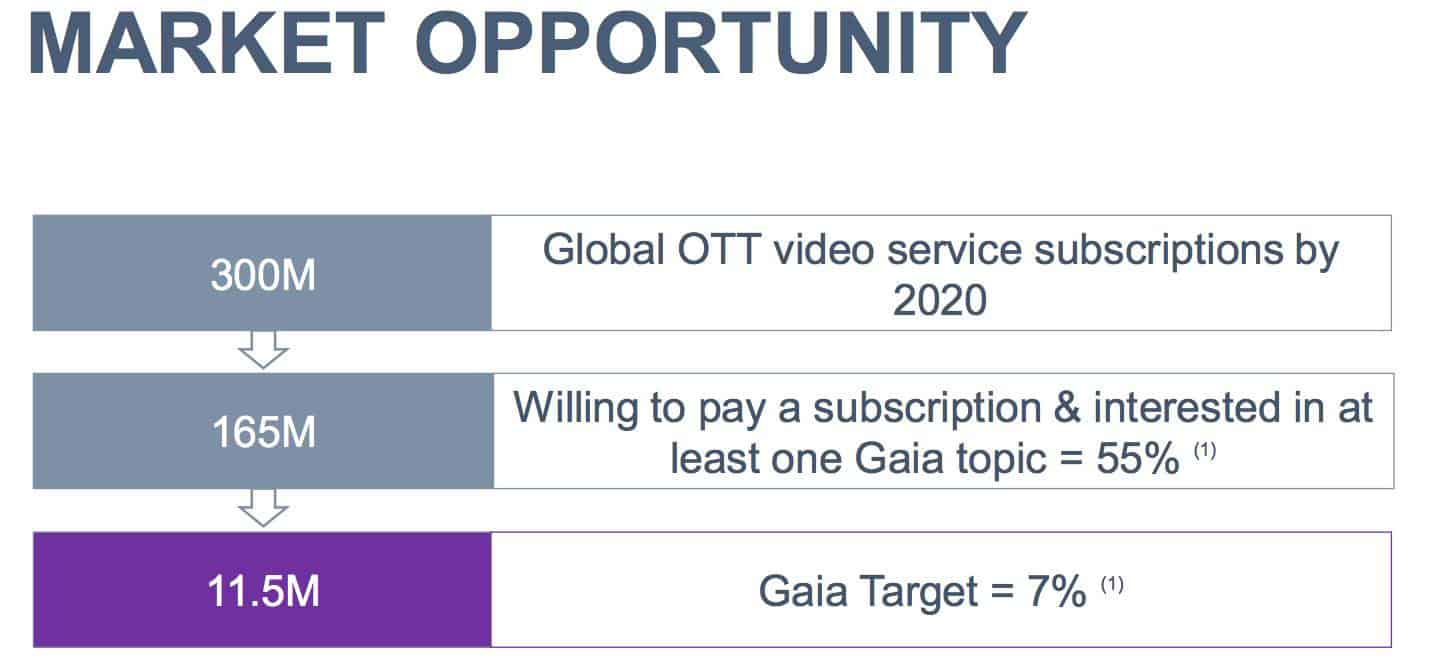When the median market PE multiple is at its highest level in history and heading higher, it’s nearly impossible to find investments that have long-term holding potential. Stock market tops are a trader’s purgatory — it’s far too early to start shorting, but going long is just as much of a crapshoot.
With that said, there are still some hidden value/growth opportunities that are improperly discounted by the market. To find them you just have to sift through the more overlooked areas of the market, which often means diving into the microcap space.
This involves digging through hundreds of junk stocks to only occasionally find a diamond in the rough, the one that has the real 10+ bagger potential.
After digging through hundreds micro cap stocks over the last month, I’ve come across one that has huge potential. The company is called Gaia and it’s run by an unusual CEO.
I remember digging into this company a few years ago. At the time, I thought it was interesting but lacked direction, so I passed on it.
But over the years it’s stuck with me and I’ve continued to check up on it from time to time. The reason I do so is because of the founder and now CEO (he’s recently returned to lead the company after an 8 year hiatus).
That man is Jirka Rysavy, and he’s unlike any other successful CEO you’ll ever read about.
Rysavy originally hails from Czechoslovakia, where he was a national champion hurdler. He escaped Soviet rule during the 80’s and fled to America where he spent a good deal of time walking across the country and sleeping on park benches.
In 1984, with hardly any money or formal business training, he started an office supplies distributor.
He took a page from Sam Walton’s playbook and sought to revolutionize the highly fragmented office supplies space by selling cheaper and more efficiently than anyone else. In this vein, he was highly successful.
In under a decade his company “Corporate Express” became the largest office supplies distributor in the world, as well as a Fortune 500 company. In 98’ Rysavy sold Corporate Express to a Dutch firm for $2.3B.
During this time Rysavy also started a number of other companies that ranged from an organic market (which later became Wild Oats and was bought by Whole Foods) to a solar power company and nutritional supplements maker, all while still finding time to train for the Olympics with his native track team. Simply put, the man is a serial entrepreneur and an unusual one at that.
Even after accumulating a net worth that’s in the hundreds of millions, Rysavy chooses to live on a small secluded plot of land in the mountains of Colorado. It’s a tiny log cabin with no running water and little in the way of amenities — he sleeps on the ground in a sleeping bag. Once, when asked in one of his very few interviews, why he chooses to live so frugally, he responded “I have everything I always wanted. Just because I have money, why should I buy extra stuff?”
You can read up some more on one of America’s most interesting CEOs here.
I’m putting emphasis on Rysavy because the trade thesis behind Gaia is largely a case of betting on the jockey.
An exceptional jockey (management, leader) can make up for a lot of the present day shortcomings of a company. Just like great stocks, exceptional management is tough to come by. There’s only so many Steve Jobs, Mark Zuckerbergs, and Jirka Rysavys in the world.
When the opportunity arises where you have a rock star leader and a company with a long runway and low stock price… you get an amazing investment opportunity.
That’s what we have here with Gaia.
Gaia was started by Rysavy in 1998 immediately after he sold his office supplies company. It started off as a lifestyle brand that produced yoga clothing and nutritional supplements. At its peak 10 years ago it was doing roughly $300 million in revenue a year. But in 2008 Rysavy stepped down as CEO and the company lost direction. As a result, it saw sales and earnings decline.
This past year, Rysavy, apparently tired of meditating in the mountains and practicing his sun salutations, returned as CEO and has completely pivoted and refocused the company.
He’s sold off its large branded yoga apparel business for $167M and its travel business for $12M, leaving just a video streaming business and a large pile of cash. Gaia used some of that cash to buy back 40% of the company last July. Rysavy now owns 38% of the company.
The new Gaia is gunning to become the Netflix for the “New Age”, making it a play on the trend towards distributed and specialty programming in television. It’s creating a platform subscription business. I love these types of businesses.
Gaia’s content ranges from guided meditations and yoga, to holistic nutrition, parenting, spirituality, and some paranormal shows that are really out there (they make the History channel’s Ancient Aliens look like sober academia).
It’s safe to say that Gaia is going after a niche market. But because of its online streaming platform and global reach, this niche is potentially very large.
Gaia produces the vast majority of its content in-house. It has a number of Gaia stars or “gurus” that are paid on the number of subscribers they attract to the platform. This makes for low-cost customer acquisition and aligns incentives between the platform and its content creators.
Subscribers can watch Gaia’s content through its newly optimized VSOD site or through one of its many partners like: Apple TV, Roku, Amazon, Hulu, Comcast and Verizon. On average, users pay $10 a month for a subscription.
Like Netflix, the investment thesis is all about growth potential. So what does that look like so far?
As of last quarter, Gaia saw subscription growth of 52% over the year prior, bringing the total subscribers to 202,000 with members in 140 countries.
Given that Gaia started from scratch just three years ago and streaming video was just an afterthought of the business until last year, that’s impressive growth.
One of the many great things about the online platform business model is that the trend growth is not linear, it’s exponential. That’s how Netflix was able to more than 3x its subscriber base in under four years. Gaia can do the same.
According to Bespoke Research Group, there’ll be an estimated 300 million video streaming customers around the globe by 2020. Out of those 300 million, 55% are interested and willing to pay for at least one Gaia topic.
Gaia will only get to a fraction of the total addressable market, but that’s all they need for the stock to rise by a few multiples.
Right now, the company is projecting 80% subscriber growth for this year and the next. They expect to hit 1 million paying subscribers in 3 years time. With their expected margins, they should reach $60 million in pretax earnings within 5 years. With only 15.1 million shares outstanding, that would give the company an earnings per share of $2.50.
And here’s the thing, we think these growth projections are on the conservative side. Rysavy has a long history of under promising and over delivering.
The company is currently losing money, but this is by design. Gaia has to expense all the costs of acquiring new customers as they’re incurred, but revenues from new customers are realized over their lifetimes, creating a mismatch between expenses and revenues. They could be profitable at current subscriber levels, but are foregoing current profitability to focus on growth, which is the right strategy.
Even though Gaia is unprofitable at the moment, they’re fully funded and shouldn’t have to access any additional financing as they grow. In fact, there’s a lot of safety in buying the stock at current levels.
Currently the company has $50M+ in cash that covers nearly 40% of its market cap. Gaia also owns a large campus that is less than 20% occupied by the company. The property and land values are estimated to be worth at least $20M. They also have 77,000 titles in their video library equating to around 7,400 hours of content, which is worth approximately $20M.
This means that at the current market cap of $132M, roughly 60% of the market cap is covered by cash and property alone. With no debt, our downside is protected.
Assuming Gaia is able to hit its conservative growth targets over the next four years, and given a very modest 10x multiple on those assumed earnings, we arrive at a market cap of approximately $350M… roughly 3 times what it is today — and that’s our conservative case.
Simply put, with Gaia you get a niche company with little to no current competition, that’s run by a serial entrepreneur who owns nearly 40% of the business (major skin in the game) and who has a long track record of being able to rapidly grow businesses. This trade is undiscovered for the time being, but once other investors see the potential here, the stock should take off. A three bagger is our base case.
Want to find another potential 10-bagger like GAIA? Then check out our Explosive Stocks Cheat Sheet here.











